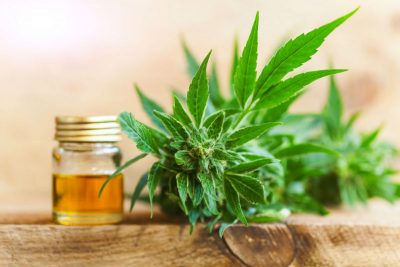
When you’re new to CBD, also known as cannabidiol oil, there’s a lot to learn — it can feel overwhelming. We’re breaking down the ABCs of CBD so you can be a more informed consumer and feel comfortable and confident making choices that impact your health. A quick read through this, and you’ll be able to start treating a variety of ailments with safe, effective, plant-based medicine.
What is CBD?
The acronym that’s been all over your news feed? This is what you need to know about the cannabis-derived wonder herb that’s the new star of holistic health. Let’s take a look.
- CBD stands for cannabidiol
- CBD is a phytocannabinoid, which means it’s a plant compound from cannabis
- Phytocannabinoids interact with the endocannabinoid system (ECS) which is a system in the human body. Different cannabinoids interact with different parts of the body, like the brain, nervous system, and muscles to deliver different effects. This is why CBD has a different effect than THC.
- There are over 100 cannabinoids, and THC is the only one that produces a euphoria/intoxication (high). CBD does not produce a high.
- CBD can be found in both types of cannabis plants: hemp and marijuana. Hemp tends to be high in CBD, low in THC content. Marijuana tends to be high in THC, low in CBD content. Therefore, most CBD comes from hemp.
Difference Between CBD and THC
So those phytocannabinoids we just talked about — the two most popular are CBD and THC. There are similarities and differences, so let’s break those down.
- THC and CBD have many similarities; they can both treat pain and inflammation, they can help with sleep, and they can help with certain mood disorders.
- The primary difference between CBD and THC is that CBD does not produce the euphoric head high; it’s classified as non-psychoactive (though that language may be changing as research within the hemp and cannabis world rapidly develops and chases).
- CBD is legal in all 50 United States. THC is not yet legal at the federal level, but it is within certain states, including Colorado and California.
- Some products combine CBD and THC to create tinctures with a synergistic effect. This is called the “entourage effect” and some doctors and cannabis experts believe that the compounds are more effective when used together.
- CBD is mostly used medically for epilepsy, anxiety, depression, and inflammation; THC is most popularly used medically for glaucoma, increasing appetite in cancer patients, and sleep. While they can both help with certain mood disorders, pain, inflammation and sleep, there are certain ailments that one compound is more suited to than the other
What Is CBD Used For?
There are dozens of science-backed benefits of CBD, and more are being researched and discovered at a lightning fast rate thanks to recent lifts of cannabis prohibition in several states. Because scientists can now delve into the world of hemp research without risking their licenses, we’re on the precipice of incredibly exciting medical news and potential cures.
At present, here are the ailments and conditions CBD is commonly used for that have been researched at least in pre-clinical studies.
- Anxiety
- Psychosis
- Depression
- Bipolar disorder
- Stress
- Sleep/Insomnia
- Inflammation
- Epilepsy
- Tremors
- Degenerative disease
- Cancer/tumors
- Skin ailments such as acne, eczema, and psoriasis
- Dyspareunia
- Arthritis
- Chronic pain
- Migraines
- Motion sickness
- Nausea
- Heart disease
Does CBD Have Side Effects?
The World Health Organization (WHO) has declared CBD to be safe with rare (if any) side effects. As mentioned, there is no head high, but everyone’s reaction will be unique (just as some people can eat a piece of bread with no problem, while those with a gluten sensitivity will get very sick), so consult your doctor when adding CBD to your routine.
Some potential side effects that may occur if you are sensitive to CBD or have potentially taken too much:
- Dry mouth
- Dizziness
- Nausea
- Drowsiness
- Diarrhea
It’s important to know that while there are not many side effects and the listed ones are rarely reported, CBD is contraindicated with certain medications. Because CBD is digested by a specific enzyme in the liver — the same enzyme that breaks down certain medications (including chemotherapy) — it can interfere with how much medication your body absorbs. It’s imperative that before adding any supplement (yes, even natural supplements!) that you consult your doctor.
How Much CBD Should You Take?
Deciding on a dose can be tricky as there’s not an exact science as of yet; the doctor recommendation is typically “start low and go slow.” While some patients feel relief from five to 15 milligrams, clinical trials report efficacy at 800 to 1,000 milligrams.
Dose also depends on delivery: whether you take a sublingual tincture under the tongue, vaporize a cartridge, eat a gummy, swallow a pill, drink a tea, or use a topical salve.
Some brands use a chart that has been used with pediatric patients, suggesting one milligram of CBD per 10 pounds of bodyweight, but this is not yet regulated by the FDA or any medical organization in particular. However, at a dose this low, it likely can’t hurt to try. Make sure you work with your doctor!
How Do You Take CBD Oil?
How you take CBD oil largely depends on preference and ailment. For example, if you have a skin ailment or muscular pain, you’d want a topical treatment. If you have anxiety or epilepsy, your delivery would be consumed either via vaporization, sublingual tincture, or edible (including capsule/pill).
When it comes to consumption versus topical application, the results will vary. Something that is digested will be absorbed differently than something delivered under the tongue or to the lungs. Digestion is a slower process giving slow, sustained results; delivery to lungs or under the tongue absorbs into capillaries for quicker effects.
Whether you choose oils, creams, capsules, gummies, teas, chocolates, or protein powders, you’ll still get the therapeutic effects of CBD. Choose what feels best for your body and your lifestyle.
How Do You Make Sure Your CBD Oil Actually Has CBD In It?
Yes, this is a real concern! The FDA recently conducted a study that showed a large amount of products advertised as “CBD” didn’t actually contain CBD oil, or contained significantly less CBD. So what’s a consumer to do?
Ask the brand you’re buying from to provide a COA: certificate of analysis.
This little PDF is proof that a third-party, independent lab tested the batch of product they’re selling to ensure it’s safe, free of mold and toxins, and contains the advertised amount of CBD and/or THC. It may also show you where the hemp was grown, where the product was tested, and if the lab has been inspected by the FDA.










